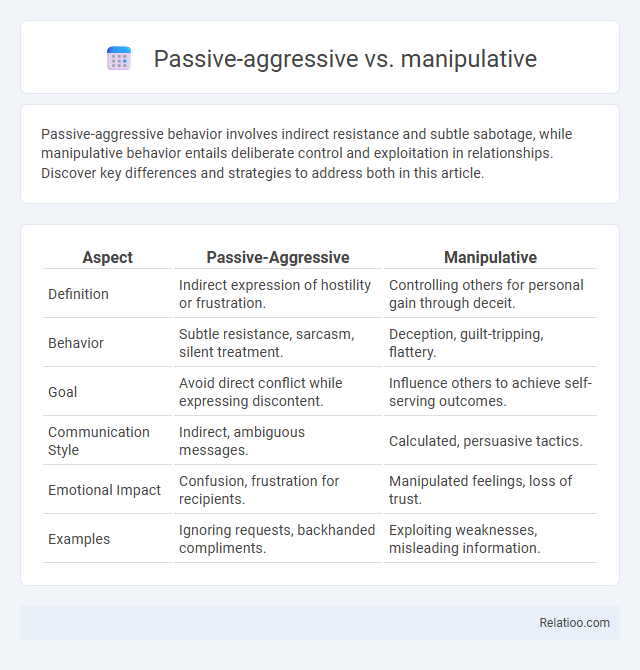Passive-aggressive behavior involves indirect resistance and subtle sabotage, while manipulative behavior entails deliberate control and exploitation in relationships. Discover key differences and strategies to address both in this article.
Table of Comparison
| Aspect | Passive-Aggressive | Manipulative |
|---|---|---|
| Definition | Indirect expression of hostility or frustration. | Controlling others for personal gain through deceit. |
| Behavior | Subtle resistance, sarcasm, silent treatment. | Deception, guilt-tripping, flattery. |
| Goal | Avoid direct conflict while expressing discontent. | Influence others to achieve self-serving outcomes. |
| Communication Style | Indirect, ambiguous messages. | Calculated, persuasive tactics. |
| Emotional Impact | Confusion, frustration for recipients. | Manipulated feelings, loss of trust. |
| Examples | Ignoring requests, backhanded compliments. | Exploiting weaknesses, misleading information. |
Understanding Passive-Aggressive Behavior
Passive-aggressive behavior often involves indirect resistance and subtle manipulation to express negative feelings without open confrontation. Understanding this behavior helps you recognize its manifestations, such as procrastination, sarcasm, or silent treatment, which differ from overt manipulation aimed at controlling others. Identifying passive-aggressive tendencies enables clearer communication and healthier conflict resolution strategies.
Defining Manipulative Behavior
Manipulative behavior involves subtly influencing or controlling others to achieve personal gain, often through deceptive, exploitative, or indirect tactics. Unlike passive-aggressive actions, which express hidden resentment or resistance, manipulative behavior is an intentional strategy to exploit vulnerabilities for power or advantage. Understanding these differences helps you recognize when someone is deliberately attempting to control your decisions or emotions under the guise of cooperation or friendliness.
Key Differences Between Passive-Aggressive and Manipulative Actions
Passive-aggressive behavior involves indirect resistance and hidden hostility, often expressed through procrastination or sarcasm, while manipulative actions are deliberate attempts to control or influence others for personal gain through deception or coercion. Understanding these key differences helps you recognize when someone is subtly undermining you versus actively exploiting your trust. Both behaviors damage relationships, but manipulation tends to be more strategic and calculated compared to the typically reactive nature of passive-aggression.
Psychological Motivations Behind Each Behavior
Passive-aggressive behavior often stems from a desire to express anger or resentment indirectly due to fear of confrontation, while manipulative behavior is driven by a need for control or personal gain at the expense of others. Passive behavior typically originates from feelings of helplessness or avoidance of conflict, leading to withdrawal rather than direct communication. Understanding these psychological motivations helps you identify underlying emotional needs and address interactions more effectively.
Common Signs of Passive-Aggressive People
Common signs of passive-aggressive people include indirect resistance to demands, frequent procrastination, and subtle sabotage of tasks or relationships. They often express negative feelings through sarcasm, backhanded compliments, or silent treatment rather than direct communication. Recognizing these behaviors helps distinguish passive-aggressiveness from manipulative tactics, which involve more overt control and exploitation.
Typical Traits of Manipulative Individuals
Manipulative individuals often exhibit traits such as deceitfulness, exploitation of others' weaknesses, and a calculated approach to influence or control situations for personal gain. They typically mask their true intentions behind charm or feigned innocence, making their actions difficult to detect. Unlike passive-aggressive behavior, which involves indirect resistance and subtle expressions of anger, manipulation is more deliberate and strategically aimed at achieving hidden agendas.
Impact on Relationships and Communication
Passive-aggressive behavior subtly undermines relationships by expressing negative feelings through indirect actions, causing confusion and mistrust. Manipulative tactics directly exploit others' vulnerabilities to control or deceive, severely damaging trust and open communication. Understanding these dynamics helps you identify harmful patterns and fosters healthier, more transparent interactions.
Recognizing Passive-Aggressive vs. Manipulative Patterns at Work
Recognizing passive-aggressive versus manipulative patterns at work involves identifying subtle behaviors that undermine communication and trust; passive-aggressive actions often include procrastination, sarcasm, or backhanded compliments, while manipulative tactics involve deceit, guilt-tripping, or exploitation to control outcomes. Your ability to discern these behaviors can improve conflict resolution and maintain a healthier workplace environment. Awareness of these distinctions empowers you to address issues assertively and protect your professional boundaries.
Strategies to Address and Respond Effectively
Addressing passive-aggressive, manipulative, and aggressive behaviors requires clear boundaries and assertive communication tailored to each style. Passive-aggressive behavior responds well to direct but calm confrontation to clarify feelings, while manipulative tactics necessitate recognizing attempts at control and maintaining emotional detachment to avoid being exploited. Your best strategy involves identifying the behavior, responding with firm, respectful language, and seeking professional support if patterns persist to protect your emotional well-being.
Promoting Healthy Communication to Prevent Toxic Dynamics
Passive-aggressive behavior often involves indirect resistance and subtle hostility, while manipulative actions are characterized by intentional control and deceit to influence others. Promoting healthy communication requires recognizing these patterns and encouraging open, honest dialogue that fosters trust and respect in Your relationships. Setting clear boundaries and practicing empathy can prevent toxic dynamics and support emotional well-being.

Infographic: Passive-aggressive vs Manipulative
 relatioo.com
relatioo.com